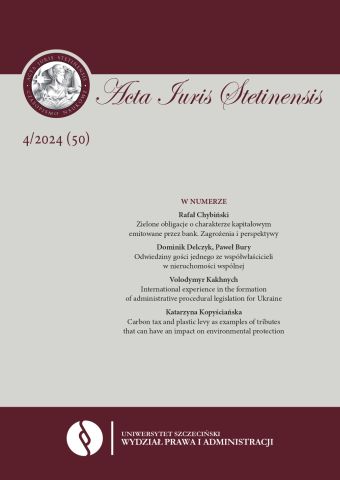Carbon tax and plastic levy as examples of tributes that can have an impact on environmental protection
Carbon tax and plastic levy as examples of tributes that can have an impact on environmental protection
Author(s): Katarzyna KopyściańskaSubject(s): Law, Constitution, Jurisprudence, EU-Legislation, Administrative Law
Published by: Wydawnictwo Naukowe Uniwersytetu Szczecińskiego
Keywords: CBAM – Carbon Boundary Adjustment Mechanism (carbon tax); European Green Deal; Fit for 55; CO2 emissions; SUP Single Plastic Use; plastic levy
Summary/Abstract: The basic aim of this article is to examine the benefits and threats for consumers and the environment resulting from the introduction of the Carbon Border Adjustment Mechanism (hereinafter: CBAM) and Single Use Plastic (hereinafter: SUP) in the European Union. Due to the too short period of validity of the analyzed regulations, this goal can only be achieved at the level of assessment of the law in force, i.e. by comparing the assumptions of the “originators” of the analyzed regulations with the method of their implementation into Polish regulations, also comparing it with currently biding regulations, such as the CO2 emissions trading mechanism (EU ETS). Climate protection is primarily about reducing the negative impact of human activity on the atmosphere. This impact mainly involves excessive emissions of greenhouse gases into the air in the course of technological processes, such as burning coal to generate electricity. Climate change is a global problem that requires global solutions. As the EU increases its climate ambitions and as less stringent climate policies prevail in many non-EU countries, there is a risk of so-called carbon leakage. Carbon leakage occurs when EU-based companies move carbon-intensive production abroad to countries with less stringent climate policies than in the EU, or when EU products are replaced by imported products with higher carbon emissions. The EU CO2 Emissions Trading System (EU ETS) was launched in 2005. Nearly two decades later, were are witnessing the implementation of a solution that has the potential to reduce the phenomenon of “emission leakage” more than previous measures. The Carbon- Based Price Adjustment Mechanism (CBAM) heralds a breakthrough tool for imposing a fair price on the carbon emitted in the production of carbon-intensive goods that enter the EU, and for encouraging cleaner industrial production in non-EU countries. The phasing-in of CBAM is aligned with the phasing out of free allocation under the EU Emissions Trading Scheme (ETS) to support the decarbonisation of EU industry. Nevertheless, a key question should be asked whether CBAM actually shapes a coherent systemic framework for CO2 and whether it does not raise significant doubts regarding its compliance with international agreements binding on the European Union and its economic sense. Moreover, from 1 January 2024, a new fee for single-use plastic products will apply in Poland. The so-called “plastic tax” is another step towards reducing environmental pollution. It aims to encourage consumers to use reusable products and reduce the amount of plastic waste. The article uses the dogmatic-legal method, taking into account current literature and applicable legal regulations.
Journal: Acta Iuris Stetinensis
- Issue Year: 2024
- Issue No: 50 (4)
- Page Range: 91-104
- Page Count: 14
- Language: English

